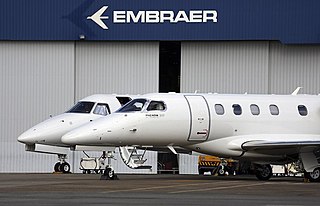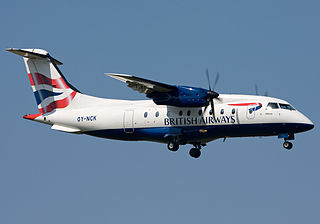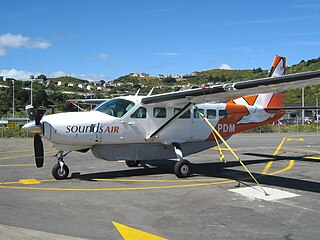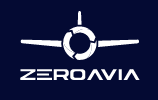Finnair is the flag carrier and largest full-service legacy airline of Finland, with headquarters in Vantaa on the grounds of Helsinki Airport, its hub. Finnair and its subsidiaries dominate both domestic and international air travel in Finland. Its major shareholder is the government of Finland, which owns 55.9% of its shares. Finnair is a member of the Oneworld airline alliance.

Embraer S.A. is a Brazilian multinational aerospace corporation. It designs, develops, manufactures, and sells aircraft and aviation systems, and provides leasing, equipment, and technical support services. Embraer is the world's third largest producer of civil aircraft after Boeing and Airbus, the leading manufacturer of both regional and light jets, and among the top 100 defense contractors. The company is headquartered in São José dos Campos, São Paulo, Brazil, with offices and operations in China, the Netherlands, Portugal, Singapore, and the United States.

ATR is a Franco-Italian aircraft manufacturer headquartered in Blagnac, France, a suburb of Toulouse.

The ATR 72 is a twin-engine turboprop, short-haul regional airliner developed and produced in France and Italy by aircraft manufacturer ATR, a joint venture formed by French aerospace company Aérospatiale and Italian aviation conglomerate Aeritalia. The number "72" in its name is derived from the aircraft's typical standard seating capacity of 72 passengers.

A regional airliner or a feeder liner is a small airliner that is designed to fly up to 100 passengers on short-haul flights, usually feeding larger carriers' airline hubs from small markets. This class of airliners is typically flown by the regional airlines that are either contracted by or subsidiaries of the larger airlines. Regional airliners are used for short trips between smaller towns or from a larger city to a smaller city. Feeder liner, commuter, and local service are all alternative terms for the same class of flight operations.

The De Havilland Canada DHC-8, commonly known as the Dash 8, is a series of turboprop-powered regional airliners, introduced by de Havilland Canada (DHC) in 1984. DHC was bought by Boeing in 1986, then by Bombardier in 1992, then by Longview Aviation Capital in 2019; Longview revived the De Havilland Canada brand. Powered by two Pratt & Whitney Canada PW150s, it was developed from the Dash 7 with improved cruise performance and lower operational costs, but without STOL performance. The Dash 8 was offered in three sizes: the initial Series 100 (1984-2005) and the more powerful Series 200 (1995-2009) with 37-40 seats, the Series 300 (1989-2009) with 50-56 seats, and Series 400 (1999-Present) with 68-90 seats. The QSeries are post-1997 variants fitted with active noise control systems.

The Dornier 328 is a turboprop-powered commuter airliner. Initially produced by Dornier Luftfahrt GmbH, the firm was acquired in 1996 by Fairchild Aircraft. The resulting firm, named Fairchild-Dornier, manufactured the 328 family in Oberpfaffenhofen, Germany, conducted sales from San Antonio, Texas, United States, and supported the product line from both locations. A jet-powered version of the aircraft, the Fairchild Dornier 328JET, was also produced.

Sounds Air is a New Zealand airline based in Marlborough. The airline was founded in 1986 by Cliff and Diane Marchant to provide low cost flights to the Marlborough Sounds. The airline's head office as well as it's Sounds Aero Maintenance division is based at Omaka aerodrome.

A regional jet (RJ) is a jet-powered regional airliner with fewer than 100 seats. The first one was the Sud-Aviation Caravelle in 1959, followed by the widespread Yakovlev Yak-40, Fokker F-28, and BAe 146. The 1990s saw the emergence of the most widespread Canadair Regional Jet and its Embraer Regional Jet counterpart, then the larger Embraer E-Jet and multiple competing projects. In the US, they are limited in size by scope clauses.

An electric aircraft is an aircraft powered by electricity. Electric aircraft are seen as a way to reduce the environmental effects of aviation, providing zero emissions and quieter flights. Electricity may be supplied by a variety of methods, the most common being batteries. Most have electric motors driving propellers or turbines.

The Bombardier CRJ100 and CRJ200 is a regional jet designed and manufactured by Bombardier Aerospace between 1991 and 2006, the first of the Bombardier CRJ family.

The Bombardier CRJ700 series is a family of regional jet airliners that were designed and manufactured by Canadian transportation conglomerate Bombardier. Officially launched in 1997, the CRJ700's maiden flight took place on 27 May 1999; it was soon followed by the stretched CRJ900 variant. Several additional variants of the type were subsequently introduced, including the elongated CRJ1000 and the CRJ550 and CRJ705, which were modified to comply with scope clauses. The CRJ program was acquired by the Japanese corporation Mitsubishi Heavy Industries in 2020, which ended production of the aircraft.
Sevenair SA, formerly branded Aero VIP, is a Portuguese regional airline headquartered in Cascais Aerodrome, western Lisbon. It operates domestic regional routes within mainland Portugal and also offers additional aviation services and non-scheduled operations in third countries. It is part of Sevenair Group, one of the biggest aeronautical groups operating in Portugal, which provides the following services: air transportation, aerial works, flying school, and aircraft maintenance.

The Garmin G3000 is an avionics interface system designed by Garmin Aviation for light turbine aircraft. The integrated touchscreen system contains multiple glass cockpit displays for operating a synthetic vision system and a three-dimensional displayed rendering of terrain.

Nordic Regional Airlines Oy is a Finnish regional airline based on the grounds of Helsinki Airport. Norra is owned as a joint venture by Finnair, Finland's flag carrier, and Danish Air Transport.
A hybrid electric aircraft is an aircraft with a hybrid electric powertrain. As the energy density of lithium-ion batteries is much lower than aviation fuel, a hybrid electric powertrain may effectively increase flight range compared to pure electric aircraft. By May 2018, there were over 30 hybrid electric aircraft projects, and short-haul hybrid-electric airliners were envisioned from 2032.

ZeroAvia is a British/American hydrogen-electric aircraft developer. The company was founded in 2017 by Valery Miftakhov, who currently serves as the company CEO. ZeroAvia is developing hydrogen-fueled powertrain technology aiming to compete with conventional engines in propeller aircraft, with an aim of zero-emission and lower noise. ZeroAvia expects to sell products by 2023 and demonstrate flights up to 500 miles (800 km) in aircraft of up to 20 seats. According to the company, by 2026, ZeroAvia intends to fly an aircraft over 500 miles range in aircraft with up to 80 seats.
Surf Air Mobility Inc. is an American aviation company focused on regional flying. The company plans to develop electric and hybrid powertrains to upgrade existing aircraft. Surf Air Mobility is the parent company of Surf Air, a charter flight operator, and two airlines, Mokulele Airlines and Southern Airways Express.

Advanced Air Mobility (AAM) is an air transport system.















